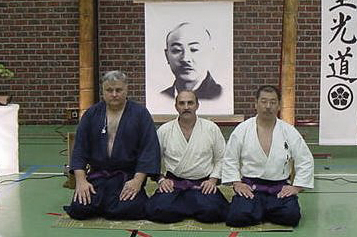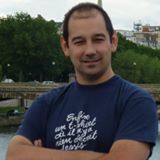| Home | Dojo | Events | Gallery | Ju Jutsu | Hakko Denshin Ryu | Contact | Links |  |
 |
|---|

Senshinkan (洗心館), whose name can be translated as "the place (館) where you purify (洗) your heart/mind (心)", is a dojo where we teach Hakko Denshin Ryu Ju Jutsu (八光伝心流柔術), a self-defence system without any violence.
The main difference with most of the other Ju Jutsu styles is the use of wrist locks and Gakun, 雅勲, pressure on kyusho (急処 or 急所, vital points situated along the meridians).
The essence of Hakko Denshin Ryu is learning the appropriate and precise gesture, and adopting the right attitude.
We hope this site will bring you some additional information about our art.
Thursday8pm-10pmSchaerbeek (Brussels) ACEPO (behind Automatic Alarm) 91 rue Metsys 1030 Schaerbeek |
Saturday9:30am-11amBrussels Swimming pool at Neder-Over-Heembeek - Dojo (at the end of the corridor situated behind the desk) 112 rue de Lombardzyde 1120 Brussels (Neder-Over-Heembeek) |
Sensei Eric Leempoels - Sensei Marc Dujardin
Technical director
Senseï Marc Dujardin, Menkyo Kaiden Shihan – San Dai Kichu, who has been trained in Europe and in Japan by
1977: started Ju-jutsu under Tielman Sensei
1983: nidan (2nd dan) Ju-jutsu under Willem Tieleman Sensei
1985: nidan (2nd dan) Aiki Goshindo under Roland Maroteaux Sensei
nidan (2nd dan) Hakko Ryu Goshindo under Roland Maroteaux Sensei
met Antonio Garcia Sensei
1987: sandan (3rd dan) Nihon Ju-jutsu under Georges Califice Sensei
1993: Hakko Ryu Ju-jutsu Okuden Shihan (mastership) in Japan under Okuyama Toshio Sensei
1998: Hakko Denshin Ryu Ju-jutsu Kaiden Shihan in Japan under Irie Yasuhiro Sensei
2006: San Dai Kichu – 7th dan Hakko Denshin Ryu under Antonio Garcia Soke
2009: Technical Director in charge of Belgium
Other arts and experiences
Vice Technical Director
1988: started Atemi-jitsu under Jean-Paul Horeman Sensei
1990: started Hakko Ryu Ju-jutsu under Marc Dujardin Sensei
1993: shodan (1st dan) Atemi-jitsu under Jean-Paul Horeman Sensei
1995: shodan (1st dan) Hakko Ryu Ju-jutsu under Marc Dujardin Sensei
1996: opened a section of the Senshinkan in Brussels
1997: nidan (2nd dan) Hakko Ryu Ju-jutsu under Marc Dujardin Sensei
1998: training in Japan under Irie Yasuhiro Sensei
2000: training in Japan under Irie Yasuhiro Sensei
2001: sandan (3e dan) Hakko Denshin Ryu Ju-jutsu under Marc Dujardin Sensei
2003: training in Japan under Irie Yasuhiro Sensei
2006: yondan (4th dan) Hakko Denshin Ryu Ju-jutsu under Marc Dujardin Sensei
2009: Shihan (5th dan) Hakko Denshin Ryu Ju-jutsu under Antonio Garcia Soke
2014: Kaiden Shihan (5th dan) Hakko Denshin Ryu Ju-jutsu under Antonio Garcia Soke
Other arts
HAKKO DENSHIN RYUThanks to have a look on our
|
OTHERTenshin Shoden Katori Shinto Ryu - SeminarThanks to have a look at the ShiShinKan's
|
The term Ju-Justu (柔術) is a Japanese word which refers to a kind, a group of disciplines or arts (術) whose efficiency lies in an appropriate and precise gesture (柔) whatever the situation may be. It is not only a self-defence method which can be traced back to the Samurai (侍) period, but it is also a way of improving oneself by practicing in a traditional way.
For a very long time oriental people have understood that suppleness and adaptability mean life, whereas hardness and stiffness are often synonymous with death: Shirobei Akiyama, a doctor from Nagasaki, is said to have observed a willow tree during a snowy winter. The branches of the tree did not resist the weight of the snow and so bent allowing the snow to eventually fall off them when they would then go back to their original (natural) position. On the other hand, the cherry tree, which resisted the weight of the snow without bending, would often have its branches broken when the accumulated snow became too heavy. Akiyama is also said to have, later on, founded a ju-jutsu style he named Yoshin Ryu (楊心流): the willow heart style/school. This non-resistance principle also influenced Jigoro Kano when he created his Kodokan Judo (講道館柔道) some 300 years later.
But let's come back to Ju-Jutsu: around 1600, after centuries of wars, conflicts and unrest, a long era of relative peace was established in Edo (currently Tokyo) and spread throughout the country. Influenced by the Bushido (武士道: honour code of the Samurai) and the spiritual value of some masters, the Ju-Jutsu Ryuha (流派: schools/styles) were at the origin of new researches with a more educational, philosophical or even sometimes religious aim. The martial techniques/arts (Bugei, 武芸) became Budo (武道: the Path of the Combat) and the support for spiritual improvement.
More then just making oneself able to defeat one or even several opponents, Ju-Jutsu allows oneself to develop qualities such as observation, control, stability, adaptability, respect for others, health … and harmony. This is still the challenge that traditional Ju-Jutsu schools offer in our modern world.
Master Okuyama Ryuho (奥山龍峰) was born in 1901 and died in 1987. In addition to traditional Japanese medicine and oratorical science, he studied several Ju-Jutsu and weapon Ryuha (流派: schools/styles), especially Daito Ryu Aikijujutsu (大東流合気柔術) that he learned from Matsuda Toshimi, then directly under Takeda Sokaku (武田惣角) for a short period.
In 1941, he presented his own method, making a synthesis between the Japanese martial tradition and the needs of our time. He became thus the Shodai Soke (初代宗家: founder) of Hakko Ryu. "Hakko" (八光) can be translated by Eighth Light, and "Ryu" (流), by School, Style.
The meaning of this school's name is that true efficiency is invisible to the eyes as are the ultra-violet rays (eighth colour on the spectrum of light, invisible but very powerful).
Okuyama Soke died in 1987.
In 1997, many practitioners, willing to preserve the spirit and teachings of Shodai Soke Okuyama, formed a new association called Kokodo Renmei (皇光道連盟) and founded a new school: the Hakko Denshin Ryu (八光伝心流) whose name can be translated as "Eighth Light Original Spirit School".
The founders of Kokodo Renmei (皇光道連盟) are (from left to right): Michael J. LaMonica, Antonio Garcia and Yasuhiro Irie (入江安博).

The direction of Hakko Denshin Ryu is represented by : Michael J. LaMonica, Soke for America, and Antonio Garcia, Soke for Europe.
As Hakko Ryu, Hakko Denshin Ryu is composed of three parts:
A self-defence system without any violence. The main difference with most of the other ju-jutsu styles lies in the use of wrist locks and Gakun, 雅勲, pressure on kyusho (急処or急所, vital points situated along the meridians, called "kei" in japanese 経). The essence of Hakko Denshin Ryu is learning the appropriate and precise gesture, and adopting the right attitude.
After the Kyu grades (i.e. before the black belt), the progression of the practitioner is marked by five Dan grades. To each of these levels corresponds the study of a Kata (形 or 型: organised and coherent set of basic techniques) which must be sufficiently assimilated to allow the study of the next level. Once he has reached the 5th dan level, the practitioner, called "expert", will receive a more esoteric teaching that will bring him till the mastership titles: Okuden Shihan(奥伝師範) and Kaiden Shihan(皆伝師範). His belt will be a purple one. This corresponds in many other martial arts to the red and white belt. The highest level of this esoteric teaching is called San Dai Kichu (三大基柱), which can be translated as "the three big pillars".
Shi (指) means "finger" and atsu (圧), "pressure". Shiatsu is a technique aiming at maintaining or recovering the energetical balance our body needs to be healthy.
Goshin (護身) signifie "protection, défense" et taiso (体操) "gymnastique". Le Goshin Taiso est une gymnastique visant également à maintenir l'équilibre des forces qui nous animent. Il se pratique seul et permet aussi à chacun de poser un bilan énergétique. Goshin (護身) means "protection" or "defence" and taiso (体操) "gymnastic". Goshin Taiso is a gymnastic used to maintain the equilibrium of the forces present in our body. It is practised alone and allows any individual to make his own energetical evaluation.




